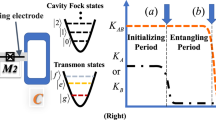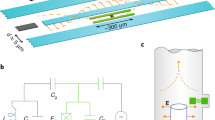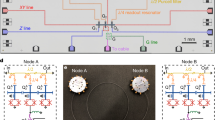Abstract
Coupling isolated quantum systems through propagating photons is a central theme in quantum science1,2, with the potential for groundbreaking applications such as distributed, fault-tolerant quantum computing3,4,5. To date, photons have been used widely to realize high-fidelity remote entanglement6,7,8,9,10,11,12 and state transfer13,14,15 by compensating for inefficiency with conditioning, a fundamentally probabilistic strategy that places limits on the rate of communication. In contrast, here we experimentally realize a long-standing proposal for deterministic, direct quantum state transfer16. Using efficient, parametrically controlled emission and absorption of microwave photons, we show on-demand, high-fidelity state transfer and entanglement between two isolated superconducting cavity quantum memories. The transfer rate is faster than the rate of photon loss in either memory, an essential requirement for complex networks. By transferring states in a multiphoton encoding, we further show that the use of cavity memories and state-independent transfer creates the striking opportunity to deterministically mitigate transmission loss with quantum error correction. Our results establish a compelling approach for deterministic quantum communication across networks, and will enable modular scaling of superconducting quantum circuits.
This is a preview of subscription content, access via your institution
Access options
Access Nature and 54 other Nature Portfolio journals
Get Nature+, our best-value online-access subscription
$29.99 / 30 days
cancel any time
Subscribe to this journal
Receive 12 print issues and online access
$209.00 per year
only $17.42 per issue
Buy this article
- Purchase on Springer Link
- Instant access to full article PDF
Prices may be subject to local taxes which are calculated during checkout




Similar content being viewed by others
References
Kimble, H. J. The quantum internet. Nature 453, 1023–1030 (2008).
Northup, T. E. & Blatt, R. Quantum information transfer using photons. Nat. Photon. 8, 356–363 (2014).
Jiang, L., Taylor, J. M., Sørensen, A. S. & Lukin, M. D. Distributed quantum computation based on small quantum registers. Phys. Rev. A. 76, 062323 (2007).
Nickerson, N. H., Li, Y. & Benjamin, S. C. Topological quantum computing with a very noisy network and local error rates approaching one percent. Nat. Commun. 4, 1756 (2013).
Monroe, C. et al. Large-scale modular quantum-computer architecture with atomic memory and photonic interconnects. Phys. Rev. A. 89, 022317 (2014).
Chou, C. W. et al. Measurement-induced entanglement for excitation stored in remote atomic ensembles. Nature 438, 828–832 (2005).
Moehring, D. L. et al. Entanglement of single-atom quantum bits at a distance. Nature 449, 68–71 (2007).
Ritter, S. et al. An elementary quantum network of single atoms in optical cavities. Nature 484, 195–200 (2012).
Hofmann, J. et al. Heralded entanglement between widely separated atoms. Science 337, 72–75 (2012).
Bernien, H. et al. Heralded entanglement between solid-state qubits separated by three metres. Nature 497, 86–90 (2013).
Roch, N. et al. Observation of measurement-induced entanglement and quantum trajectories of remote superconducting qubits. Phys. Rev. Lett. 112, 170501 (2014).
Narla, A. et al. Robust concurrent remote entanglement between two superconducting qubits. Phys. Rev. X 6, 031036 (2016).
Olmschenk, S. et al. Quantum teleportation between distant matter qubits. Science 323, 486–489 (2009).
Stute, A. et al. Quantum-state transfer from an ion to a photon. Nat. Photon. 7, 219–222 (2013).
Pfaff, W. et al. Unconditional quantum teleportation between distant solid-state quantum bits. Science 345, 532–535 (2014).
Cirac, J. I., Zoller, P., Kimble, H. J. & Mabuchi, H. Quantum state transfer and entanglement distribution among distant nodes in a quantum network. Phys. Rev. Lett. 78, 3221–3224 (1997).
Pechal, M. et al. Microwave-controlled generation of shaped single photons in circuit quantum electrodynamics. Phys. Rev. X 4, 041010 (2014).
Yin, Y. et al. Catch and release of microwave photon states. Phys. Rev. Lett. 110, 107001 (2013).
Srinivasan, S. J. et al. Time-reversal symmetrization of spontaneous emission for quantum state transfer. Phys. Rev. A. 89, 033857 (2014).
Pfaff, W. et al. Controlled release of multiphoton quantum states from a microwave cavity memory. Nat. Phys. 13, 882–887 (2017).
Wenner, J. et al. Catching time-reversed microwave coherent state photons with 99.4% absorption efficiency. Phys. Rev. Lett. 112, 210501 (2014).
Flurin, E., Roch, N., Pillet, J. D., Mallet, F. & Huard, B. Superconducting quantum node for entanglement and storage of microwave radiation. Phys. Rev. Lett. 114, 090503 (2015).
Reed, A. P. et al. Faithful conversion of propagating quantum information to mechanical motion. Nat. Phys. 13, 1163–1167 (2017).
Axline, C. et al. An architecture for integrating planar and 3D cQED devices. Appl. Phys. Lett. 109, 042601 (2016).
Schuster, D. I. et al. Resolving photon number states in a superconducting circuit. Nature 445, 515–518 (2007).
Bishop, L. S., Ginossar, E. & Girvin, S. M. Response of the strongly driven Jaynes–Cummings oscillator. Phys. Rev. Lett. 105, 100505 (2010).
Sank, D. et al. Measurement-induced state transitions in a superconducting qubit: beyond the rotating wave approximation. Phys. Rev. Lett. 117, 190503 (2016).
Massar, S. & Popescu, S. Optimal extraction of information from finite quantum ensembles. Phys. Rev. Lett. 74, 1259–1263 (1995).
Ofek, N. et al. Extending the lifetime of a quantum bit with error correction in superconducting circuits. Nature 536, 441–445 (2016).
Michael, M. H. et al. New class of quantum error-correcting codes for a bosonic mode. Phys. Rev. X 6, 031006 (2016).
Campagne-Ibarcq, P. et al. Deterministic remote entanglement of superconducting circuits through microwave two-photon transitions. Preprint at http://arxiv.org/abs/1712.05854 (2017).
Kurpiers, P. et al. Deterministic quantum state transfer and generation of remote entanglement using microwave photons. Preprint at http://arxiv.org/abs/1712.08593 (2017).
Hucul, D. et al. Modular entanglement of atomic qubits using photons and phonons. Nat. Phys. 11, 37–42 (2015).
Gottesman, D. & Chuang, I. L. Demonstrating the viability of universal quantum computation using teleportation and single-qubit operations. Nature 402, 390–393 (1999).
Bennett, C. H. et al. Purification of noisy entanglement and faithful teleportation via noisy channels. Phys. Rev. Lett. 76, 722–725 (1996).
Deutsch, D. et al. Quantum privacy amplification and the security of quantum cryptography over noisy channels. Phys. Rev. Lett. 77, 2818–2821 (1996).
Acknowledgements
The authors would like to acknowledge valuable discussions with C. Zhou, A. Narla, S. Shankar and K.W. Lehnert. This work was supported by the US Army Research Office (W911NF-14-1-0011). C.J.A. was supported by the NSF Graduate Research Fellowship (DGE-1122492); L.D.B. by the ARO QuaCGR Fellowship; W.P. by the NSF (PHY1309996) and by a fellowship instituted with a Max Planck Research Award from the Alexander von Humboldt Foundation; W.P., P.R. and M.Z. by the US Air Force Office of Scientific Research (FA9550-15-1-0015); S.M.G by the NSF (DMR-1609326); L.J. by the Alfred P. Sloan Foundation (BR2013-049) and the Packard Foundation (2013-39273). Facilities use was supported by the Yale Institute for Nanoscience and Quantum Engineering (YINQE) and the Yale SEAS cleanroom.
Author information
Authors and Affiliations
Contributions
C.J.A., L.D.B. and W.P. performed the experiment and analysed the data under the supervision of R.J.S. C.J.A. and L.F. fabricated the transmon qubits. M.Z. assisted in data analysis and ran supporting simulations. M.Z., S.M.G. and L.J. provided theory support. K.C. assisted in development of a Wigner reconstruction algorithm. P.C.-I. contributed to the experimental design under the supervision of M.H.D. P.R. developed optimal control pulse software and implemented field measurement capability. C.J.A., L.D.B., W.P. and R.J.S. wrote the manuscript with contributions from all authors.
Corresponding authors
Ethics declarations
Competing interests
R.J.S., M.H.D. and L.F. are founders, and R.J.S. and L.F. are equity shareholders of Quantum Circuits, Inc.
Additional information
Publisher’s note: Springer Nature remains neutral with regard to jurisdictional claims in published maps and institutional affiliations.
Supplementary information
Supplementary Information
Supplementary notes, Supplementary figures, Supplementary references
Rights and permissions
About this article
Cite this article
Axline, C.J., Burkhart, L.D., Pfaff, W. et al. On-demand quantum state transfer and entanglement between remote microwave cavity memories. Nature Phys 14, 705–710 (2018). https://doi.org/10.1038/s41567-018-0115-y
Received:
Accepted:
Published:
Issue Date:
DOI: https://doi.org/10.1038/s41567-018-0115-y
This article is cited by
-
Protecting entanglement between logical qubits via quantum error correction
Nature Physics (2024)
-
On-demand directional microwave photon emission using waveguide quantum electrodynamics
Nature Physics (2023)
-
High-fidelity parametric beamsplitting with a parity-protected converter
Nature Communications (2023)
-
Low-loss interconnects for modular superconducting quantum processors
Nature Electronics (2023)
-
Realizing all-to-all couplings among detachable quantum modules using a microwave quantum state router
npj Quantum Information (2023)



